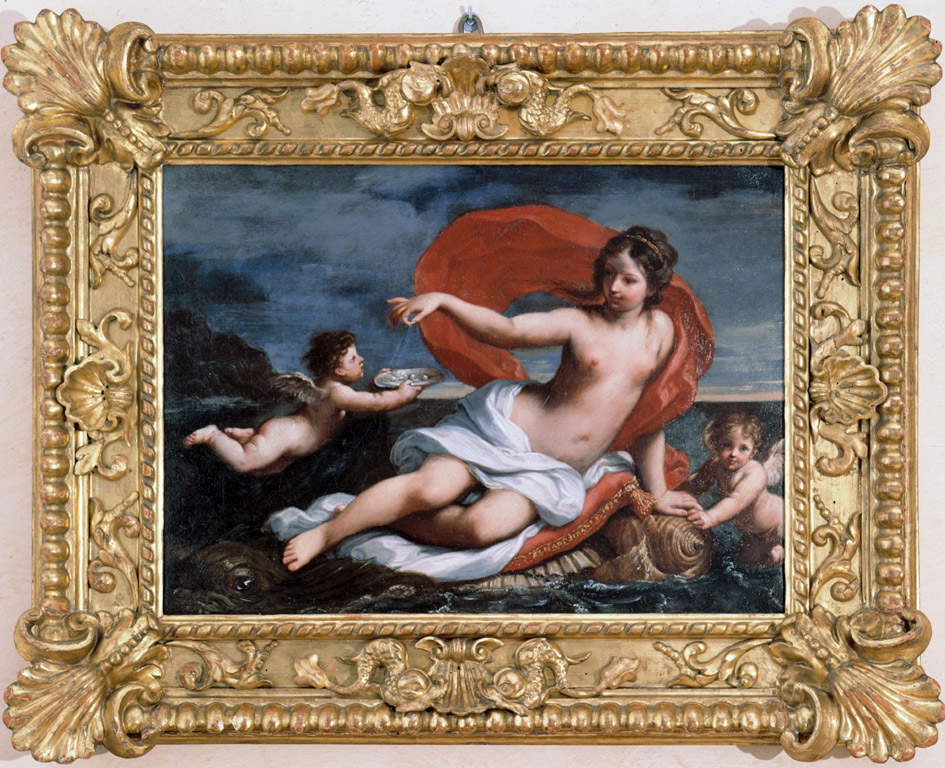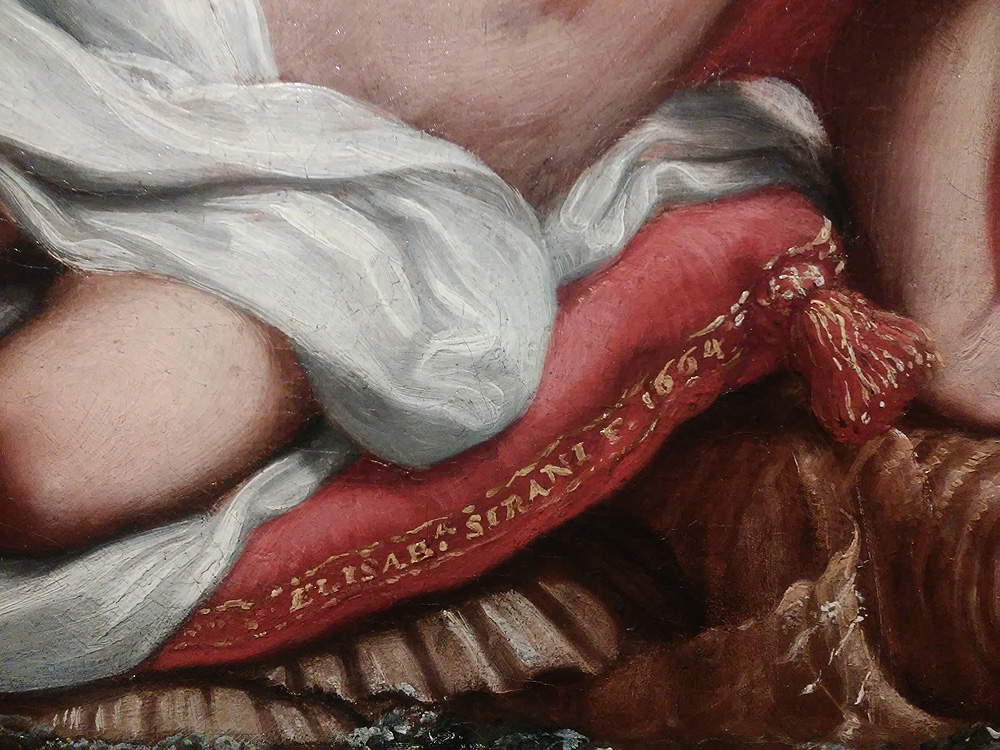Elisabetta Sirani, a precious pearl of seventeenth-century painting, had the eccentric and refined habit of affixing her signature to the most unusual and unthinkable details of her graceful paintings: a row of buttons, the cuff of a shirt, the back of a chair. In Galatea, the last canvas Elisabetta executed for Marquis Ferdinando Cospi, one of her earliest patrons, her name is stitched in gold on the edge of the cushion where the adolescent Nereid lies. To linger on this signature, however, is not only a curiosity to call the attention of a careless observer: it means, meanwhile, to focus on the mature manner of the very young artist. There is no doubt that we can speak of full maturity in speaking of this artist who died prematurely at only twenty-seven years of age: despite her green age, in this Galatea Elisabetta already reveals herself as an artist not only independent, but also fully aware of her own means. Her brushstroke is full, mellow, sensual, giving body to a free and spontaneous drawing, which seeks the effect of chiaroscuro to make the figures more expressive and animated: and in her search for the gratification of the senses through a union of drawing and color, the young Bolognese did not deviate from her masters, namely Guido Reni and Guercino, in a line of direct descent that goes back to Correggio. Ideal masters, of course: Guido Reni, for example, disappeared when Elisabetta was only four years old, but his lessons came to her through her father, Giovanni Andrea Sirani, who was Guido’s pupil as well as his closest assistant and whose fame, it can be said without fear of contradiction, was adulated by his daughter’s talent.
A talent that was recognized even by her contemporaries, who were astounded by the girl’s compositional wisdom, the mastery of her drawing, and that dazzling readiness that her colleagues admired almost in disbelief as they watched her at work. For Baldassarre Franceschini, who had seen her at work in his studio, Elisabetta was “the best brush that fusse in Bologna.” And then take Carlo Cesare Malvasia’s Felsina pittrice , reread the words the historiographer reserved for Elisabetta Sirani. First, the passage in which Malvasia condenses the young woman’s technical expertise: “having taken the pencil very quickly, and down promptly placed in two marks on white paper the thought (this was his usual way of drawing as a grand master indeed, and practiced by few, nor less by the Father himself, who will not let me lie), dipped the little brush in ink watercolor, he soon made its witty invention appear, which could be said without signs drawn, shaded, and altogether illuminated all in time.” And see again what a profusion of adjectives and compliments Malvasia reserves for the artist: “lovable beyond measure,” “worthy of eternal fame,” “prodigy in art,” “gem of Italy,” “sun of Europe,” and that “heroine painter” which we might take as a basis for understanding the historical bearing of Elisabetta Sirani’s art.
Contemporaries appreciated her quick wit, the originality of her interpretations, the happiness of her inventions. And she proudly claimed her talent: and here we come back to the relevance of her signatures, since it is in this sense that we need to read the numerous occurrences of her name in her works, a decidedly strange case for a time when paintings were not frequently signed. For Elisabetta Sirani, then, it was also a necessity, an assertive expedient the artist resorted to in order to assert her authority, should it occur to anyone to suspect the autography of her works. And unfortunately, it was not just a way of prevention: one can only imagine how frustrated the young woman must have been by those slanders to which Marquis Cospi alluded in a letter sent in 1662 to Leopoldo de’ Medici, in which the nobleman found himself forced to defend the goodness of Elisabetta’s work.
 |
| Elisabetta Sirani, Galatea (1664; oil on canvas, 43 x 58.5 cm; Modena, Museo Civico dArte) |
 |
| Elisabetta Sirani, Galatea, detail of the signature |
Cospi, who was related to the Medici, had the merit of introducing Elisabetta Sirani’s painting to the Florentine court, as well as commissioning six paintings from her: the Galatea, now at the Museo Civico in Modena (to which it came in 2008 with the legacy of the accountant Carlo Sernicoli, who wished to donate two important collector’s nuclei to the institute), is, as we have anticipated, the last canvas that the girl executed for the marquis: negl’inventarî antichi del “Museo Cospiano” it appears as “una galatea con varii amorini.” The artist executed the painting, which moreover still retains its original frame full of shells and dolphins to emphasize the marine theme, a year before her death. We know this because Elisabeth was also extremely meticulous in her daily life and kept a diary, the original of which we have lost but of which we preserve Malvasia’s reproduction, in which she noted the happenings of her days, including works of art: thus, in the diary, also a unicum for a woman of the time, the painting is minutely described as “a Galatea picciola at sea, led by duoi dolphins, with duoi amoretti, one of which bumps into certain capes, where the said Galatea is lying, and the other presents her with an open mother-of-pearl with various pearls, where she is in the act of lifting one, for the illustriss. Mr. Marquis Senator, and Bailiff Ferdinando Cospi.”
It is an exceedingly significant painting, since many features of Elisabetta Sirani’s art can be inferred from it. It was said that contemporaries were admired for the originality of her inventions: and here, instead of repeating the usual iconography of Galatea in triumph or in the company of her beloved Acis, or in dialectical relationship with her unrequited lover, the Cyclops Polyphemus, the painter restores a Galatea (petite, with sweet features, wearing a headband to stop a’fashionable hairstyle) who simply lets herself be carried away by the waves, together with two cupids, against the background of a gloomy sky and on the waves of an even gloomier sea. The vigor of her drawing, a vigor that might even have appeared masculine to contemporaries, emerges with manifest clarity not only from the very strong chiaroscuro that shapes the cupids and the nymph herself, but also from the marks and folds of thatunreal fluttering red cloth, a kind of sail puffed by the wind, inferred from homologous ideas of a Francesco Albani, which will carry far away the shell, on which, so as not to be too uncomfortable on the journey, the Nereid has arranged the fine vermilion satin cushion with golden stitching. And with what prissy grace the adolescent nymph chooses a pearl from the saucer offered to her by the winged putto, delicately taking it with forefinger and thumb and lifting her other fingers: one might discern, in this movement, as well as in the figure of the nymph with almost childlike features, a kind of summary of Elisabetta’s subjects. Fiorella Frisoni has written that Galatea, with that “affected gesture of choosing the pearl,” with “the slender bust and the turned legs,” “well represents the humanity dear to Elisabetta, a bit of a maiden, but also worldly.”
This is her feminine ideal, one might say: a young, delicate, feminine, proud woman. Exactly as she was: it was said, above, of the historical bearing of her art. In 2001, Adelina Modesti wrote that the main significance of the figure of Elisabetta lies in the “professionalization of women’s artistic practice, through the development of a method of professional training for women, outside the traditional model of the mentor man (female artists in fact learned their craft through male colleagues: fathers, husbands, brothers), and thus in having created broad avenues for female cultural production and female transmission of knowledge, having been an educator and model for the next generation of women artists.” Here then is the novelty: a woman teacher, moreover fully recognized since Elisabeth appears as a professor in the records of the Academy of St. Luke, who taught other women. One may well overlook the mythographies that might arise from the effluvium of flattery that flows between the pages of Malvasia, but when one considers Elisabetta Sirani in her role as head of the family and master of the workshop, assumed out of necessity induced by the serious infirmity that struck her father in 1662, when one considers the success the works enjoyed, it becomes impossible to downplay her historical significance. “Her legacy,” Modesti recalled again recently, “consists in having disclosed alternative avenues to education intended for women, opening her workshop to young girls who (often born into families of artists, but sometimes also in aristocratic circles), intended to venture into the field of figurative arts.” A woman who achieves success in a trade typically reserved for men even going so far as to teach it, a new alternative to the “male mentor model” then prevailing sprouted in the fertile soil of cultured Bologna in the second half of the 17th century.
If you enjoyed this article, read the previous ones in the same series: Gabriele Bella’sConcerto; Plinio Nomellini’sNinfa rossa;Guercino’s lApparizionedi Cristo alla madre; Titian’s Maddalena; Vittorio Zecchin’sMille e una notte; Lorenzo Lotto’sTrasfigurazione; Jacopo Vignali’sTobia e langelo; Luigi Russolo’sPerfume; Antonio Fontanesi’sNovembre; Cosmè Tura’s St. Maurelius Roundels; Simone dei Crocifissi’s Madonna and Child and Angels; Francesco Gioli’sScales at the Mouth of the Arno; and Pellizza da Volpedo’sMirror of Life.
Warning: the translation into English of the original Italian article was created using automatic tools. We undertake to review all articles, but we do not guarantee the total absence of inaccuracies in the translation due to the program. You can find the original by clicking on the ITA button. If you find any mistake,please contact us.